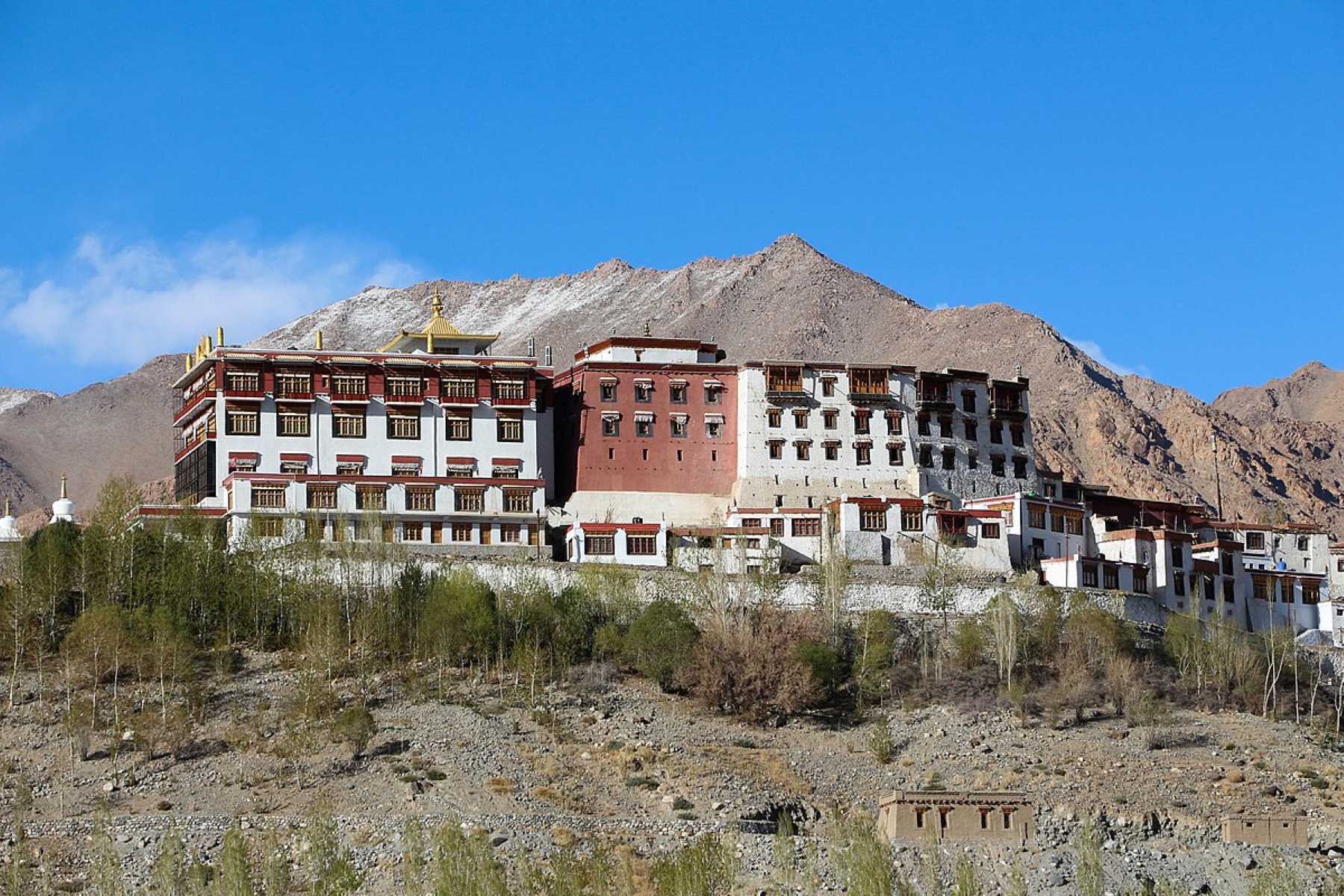
Phyang Monastery, nestled in the serene landscapes of Ladakh, India, holds a treasure trove of history and culture. Founded in the 16th century, this ancient monastery is a beacon of Buddhist teachings and traditions. Did you know that Phyang Monastery is home to a unique collection of ancient thangkas, murals, and scriptures? Visitors often marvel at the annual festival, Phyang Tsedup, which showcases vibrant Cham dances and rituals. But what makes this monastery truly special is its connection to the Drikung Kagyu lineage of Tibetan Buddhism. Whether you're a history buff, a spiritual seeker, or just curious, Phyang Monastery offers a glimpse into a world rich with tradition and tranquility. Ready to uncover more intriguing facts about this hidden gem? Let's dive in!
History of Phyang Monastery
Phyang Monastery, also known as Phyang Gompa, is one of the most significant monasteries in Ladakh, India. Its history is rich with cultural and spiritual significance.
-
Phyang Monastery was founded in 1515 by Denma Kunga Drakpa, a disciple of the renowned Tibetan Buddhist master, Jigten Gönpo.
-
The monastery belongs to the Drikung Kagyu school of Tibetan Buddhism, which emphasizes meditation and the teachings of the Kagyu lineage.
-
It was established during the reign of King Tashi Namgyal, who played a crucial role in promoting Buddhism in the region.
-
The monastery is located approximately 17 kilometers west of Leh, the capital of Ladakh.
-
Phyang Monastery is built on a hilltop, offering stunning views of the surrounding landscape.
Architectural Marvels
The architecture of Phyang Monastery is a blend of traditional Tibetan and Ladakhi styles. It features intricate designs and structures that reflect the rich heritage of the region.
-
The main assembly hall, known as Dukhang, is adorned with beautiful murals and thangkas (Tibetan Buddhist paintings).
-
The monastery houses a large statue of Skyabje Jigten Gombo, the founder of the Drikung Kagyu lineage.
-
There are several smaller chapels within the monastery complex, each dedicated to different deities and spiritual figures.
-
The monastery's walls are decorated with ancient frescoes depicting various aspects of Buddhist mythology and teachings.
-
Phyang Monastery also has a library that contains a vast collection of ancient Buddhist scriptures and texts.
Festivals and Celebrations
Phyang Monastery is known for its vibrant festivals and celebrations, which attract visitors from all over the world. These events are a testament to the monastery's cultural and spiritual significance.
-
The Phyang Tsedup Festival is one of the most important events held at the monastery. It takes place annually in July or August.
-
During the festival, monks perform traditional Cham dances, which are masked dances that depict various Buddhist deities and legends.
-
The festival also includes rituals, prayers, and the unfurling of a giant thangka, which is a sacred Buddhist painting.
-
Visitors can witness the unique rituals and ceremonies that are part of the Drikung Kagyu tradition during the festival.
-
The festival is a time of great joy and celebration for the local community, as well as for tourists who come to experience the vibrant culture of Ladakh.
Spiritual Significance
Phyang Monastery holds immense spiritual significance for the followers of Tibetan Buddhism. It serves as a center for meditation, learning, and spiritual practice.
-
The monastery is home to around 100 monks who live and study there.
-
It offers various meditation retreats and spiritual programs for both monks and laypeople.
-
The monastery's teachings focus on the practice of Mahamudra, which is a form of meditation that aims to realize the nature of the mind.
-
Phyang Monastery also conducts regular teachings and initiations by senior monks and visiting lamas.
-
The monastery's serene environment provides an ideal setting for spiritual practice and contemplation.
Cultural Heritage
Phyang Monastery is not just a religious institution; it is also a repository of Ladakh's rich cultural heritage. It plays a vital role in preserving and promoting the region's traditions and customs.
-
The monastery is involved in various cultural preservation projects, including the restoration of ancient murals and artifacts.
-
It organizes workshops and training programs to teach traditional arts and crafts to the younger generation.
-
The monastery's museum houses a collection of ancient artifacts, including statues, manuscripts, and ritual objects.
-
Phyang Monastery also plays a role in promoting traditional music and dance forms of Ladakh.
-
The monastery's cultural initiatives help to keep Ladakh's unique heritage alive for future generations.
Natural Beauty
The location of Phyang Monastery adds to its charm and appeal. Surrounded by the stunning landscapes of Ladakh, the monastery offers breathtaking views and a tranquil environment.
-
The monastery is situated in the Phyang Valley, which is known for its picturesque beauty and serene atmosphere.
-
The valley is dotted with traditional Ladakhi houses and fields, creating a scenic backdrop for the monastery.
-
The monastery's hilltop location provides panoramic views of the surrounding mountains and valleys.
-
Visitors can enjoy peaceful walks and hikes in the area, taking in the natural beauty and tranquility.
-
The monastery's gardens are well-maintained and offer a peaceful retreat for visitors.
Educational Role
Phyang Monastery is also an important center for education and learning. It provides education to young monks and plays a role in the broader educational landscape of Ladakh.
-
The monastery runs a school that provides both religious and secular education to young monks.
-
The curriculum includes subjects such as Tibetan language, Buddhist philosophy, and modern subjects like mathematics and science.
-
The monastery also offers scholarships and financial support to students from economically disadvantaged backgrounds.
-
Phyang Monastery collaborates with other educational institutions in Ladakh to promote education and literacy.
-
The monastery's educational initiatives help to empower the local community and promote the values of compassion and wisdom.
Community Engagement
Phyang Monastery is deeply involved in the local community and plays a significant role in social and cultural activities.
-
The monastery organizes various community events and programs, including health camps and environmental awareness campaigns.
-
It provides support to local artisans and craftsmen by promoting their work and providing them with a platform to showcase their skills.
-
Phyang Monastery also plays a role in promoting tourism in the region, which helps to boost the local economy and create employment opportunities.
Final Thoughts on Phyang Monastery
Phyang Monastery, nestled in the serene landscapes of Ladakh, offers a treasure trove of history and culture. From its founding in the 16th century to its vibrant annual festivals, this monastery stands as a testament to the rich heritage of Tibetan Buddhism. The intricate murals, ancient scriptures, and the majestic statue of Skyabje Jigten Gombo provide a glimpse into the spiritual and artistic achievements of the past.
Visitors can immerse themselves in the tranquil ambiance, participate in meditation sessions, or simply marvel at the architectural beauty. The monastery's role in preserving ancient traditions while adapting to modern times makes it a unique destination for both spiritual seekers and history enthusiasts.
Phyang Monastery isn't just a place of worship; it's a living museum that continues to inspire and educate. Whether you're planning a visit or just curious about its legacy, this monastery promises a memorable experience.
Was this page helpful?
Our commitment to delivering trustworthy and engaging content is at the heart of what we do. Each fact on our site is contributed by real users like you, bringing a wealth of diverse insights and information. To ensure the highest standards of accuracy and reliability, our dedicated editors meticulously review each submission. This process guarantees that the facts we share are not only fascinating but also credible. Trust in our commitment to quality and authenticity as you explore and learn with us.


